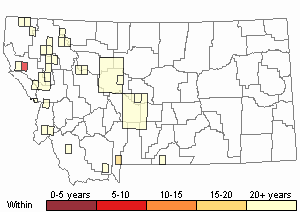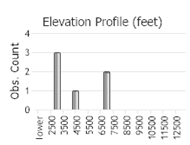View in other NatureServe Network Field Guides
NatureServe
Montana
Utah
Wyoming
Idaho
Wisconsin
British Columbia
South Carolina
Yukon
California
New York
An Orthotrichum Moss - Orthotrichum rupestre
General Description
Plants: Growing in open to crowded tufts, upper parts deep green (Flowers 1973) to olive or pale above (FNA 2014), black to brown below. Stems upright to ascending (Flowers 1973), usually with much branching, 1-12.5 cm tall (FNA 2014).
Leaves: Stem leaves rigid, upright, and flattened against the stem when dry, 2-4.5 mm in length, slenderly lanceolate or tending toward ovate (FNA 2014), strongly keeled (Flowers 1973), margins smooth, rolled toward back of leaf from base to near the tip; apex acute (FNA 2014); costa substantial, terminating at or shortly before the apex (Flowers 1973).
Leaf Cells: Basal laminal cells sometimes thick-walled and knobby, usually rectangular (Flowers 1973) and yellow in older leaves (FNA 2014); alar cells usually quadrate; upper laminal cells somewhat quadrate to rounded or oval, thick-walled, 1 cell-layer thick with 2 cell layers in places, papillose (Flowers 1973), the papillae 1 or 2 per cell, cone-shaped or forked (FNA 2014).
Range Comments
Greenland; Canada: AB, BC, NT, NU, ON, YT; USA: AK, AZ, CA, CO, ID, MT, NM, OR, SD, UT, WA, WY; South America; Europe; e Asia; n, e Africa; Atlantic Islands; Pacific Islands; Australia (FNA 2014). In Montana, known from Beaverhead, Carbon, Cascade, Flathead, Gallatin, Glacier, Judith Basin, Lake, Lincoln, Madison, Mineral, Missoula, Park, Ravalli, and Sanders Counties (Elliott 2016).
Observations in Montana Natural Heritage Program Database
Number of Observations: 53
(Click on the following maps and charts to see full sized version)
Map Help and Descriptions
Relative Density

Recency



 (Observations spanning multiple months or years are excluded from time charts)
(Observations spanning multiple months or years are excluded from time charts)
Habitat
Non-calcareous rocks and bluff faces in coniferous or aspen forests, tree bases (FNA 2014).
Reproductive Characteristics
Autoicous (Flowers 1973). Seta up to 1.8 mm. Capsule typically about 1/3 emerged, but may be completely immersed in or entirely held beyond the perichaetial bracts, short-oblong to rounded-ovate, 1.3-1.8 mm in length, sometimes conspicuously 8-ribbed for part of its length (FNA 2014), yellow to ochre (Flowers 1973), with male organs in the leaf axils (FNA 2014).
Stewardship Responsibility
References
- Literature Cited AboveLegend:
 View Online Publication
View Online Publication Elliott, J.C. and A.K. Pipp. 2018. A Checklist of Montana Mosses (1880-2018). Updated 3 January, 2020. Montana Natural Heritage Program, Helena, Montana. 73 pp.
Elliott, J.C. and A.K. Pipp. 2018. A Checklist of Montana Mosses (1880-2018). Updated 3 January, 2020. Montana Natural Heritage Program, Helena, Montana. 73 pp. Flora of North America Editorial Committee, eds. 2014. Flora of North America North of Mexico. Volume 28. Bryophytes: Mosses, Part 2. Oxford University Press, Inc., NY. xxi + 702 pp.
Flora of North America Editorial Committee, eds. 2014. Flora of North America North of Mexico. Volume 28. Bryophytes: Mosses, Part 2. Oxford University Press, Inc., NY. xxi + 702 pp. Flowers, S. 1973. Mosses: Utah and the West. Brigham Young University, Provo, Utah. 567 p.
Flowers, S. 1973. Mosses: Utah and the West. Brigham Young University, Provo, Utah. 567 p.
- Additional ReferencesLegend:
 View Online Publication
View Online Publication
Do you know of a citation we're missing? Elliot, J. C. 1993. Second checklist of Montana mosses. Unpublished report. U.S. Forest Service, Region 1. Missoula, MT. 45 pp.
Elliot, J. C. 1993. Second checklist of Montana mosses. Unpublished report. U.S. Forest Service, Region 1. Missoula, MT. 45 pp. Lawton, E. 1971. Keys for the Identification of the Mosses on the Pacific Northwest. Reprinted from 'Moss Flora of the Pacific Northwest'. Published as Supplement No. 2 of the Journal of the Hattori Botanical Laboratory. Nichinan, Miyazaki, Japan. 66 pp.
Lawton, E. 1971. Keys for the Identification of the Mosses on the Pacific Northwest. Reprinted from 'Moss Flora of the Pacific Northwest'. Published as Supplement No. 2 of the Journal of the Hattori Botanical Laboratory. Nichinan, Miyazaki, Japan. 66 pp. Lawton, E. 1971. Moss Flora of the Pacific Northwest. Hattori Botanical Laboratory. Japan: Yamabuki-cho, Shinjuku-ku, Tokyo. 362 pages plus appendices.
Lawton, E. 1971. Moss Flora of the Pacific Northwest. Hattori Botanical Laboratory. Japan: Yamabuki-cho, Shinjuku-ku, Tokyo. 362 pages plus appendices.
- Web Search Engines for Articles on "An Orthotrichum Moss"





